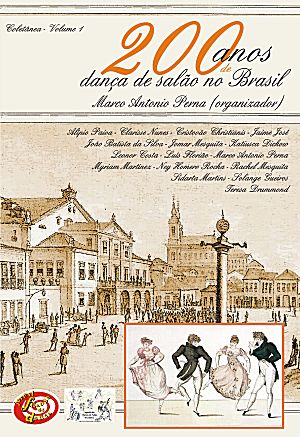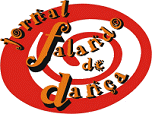|



Clique na imagem para ver a página deste site no facebook
|

Siga-nos


| |





|
Lambada History, by Chico Peltier- Ballroom Dancing Agenda by Marco Antonio Perna
| Lambada History, by Chico Peltier |
For the Portuguese version of this history, click here.
It is the most complete history I ever heard of Lambada. It was written
by a guy named Chico Peltier. He's a regular writer at the brasilian
Ballroom dancing web-list. Many thanks to him.
...(the notes in brackets ( ) are mine, in an attempt to explain to a
foreigner like you and others, things well known to brasilian people)
Here it goes...
The Lambada History
This is a quite interesting story since it is made of lots of
contemporaneous tales. It's quite difficult to get the same one
version from anybody since everyone seems to pull out the thing
to it's own favour.
I had the fine opportunity to start dancing around Brazil very before
the explosion of the so called Lambada, hence I had the chance to
follow the ascension and decline of this rythm in Brazil and in other
countries.
I have been in Pará (this is the brasilian 2nd greatest state located
at the north part of the country, very near to the south Caribeen
isles with a local and secular typical style of culture, food and
dancing) and other states down the north-eastern coast of Brazil
ending at the Bahia state, researching for this story throughout.
Hence I couldn't resist and wrote these lines to you...
The ORIGINS - The "CARIMBÓ"
Since the time Brazil was a portuguese colony (which happenned
between year 1500 a.c. till 1822 a.c.) there was a common dance
in the north part of the country called Carimbó. It was a loose
and very sensual dance in which the woman tried to cover the man
with many spins and rounded skirts. The music was played mainly
among beats of drums made of trunks of wood, thinned by fire.
As time passed by, the dance changed as did the music itself. It
had many influences from the caribeen music due to its geographical
proximity, and a reminder of this is that even today one can listen
to caribeen radio stations when at some north states of Brazil like
the Amapá state. This strong relation also generated some new rythms
like the Sirimbó and the Lari Lari, and so it changed forever the way
the Carimbó was danced.
The NAME and The FATHER
After a while, a local radio station from Belém (Pará's capital city)
started to call these new type of music as "the strong beated rythm"
and "the rythms of Lambada" (Lambada is another word in local
language for a strong hit). This last name "Lambada" had a strong
appeal and began to be associated with this new emerging face of
an old dancing style.
Then the Carimbó dance started once more to be danced in couples,
in a 2-beat style, something very close to the Merengue, but with
many spins. I once danced this kind of music back in 1983, in Belém
and Macapá (Amapá's capital city). I also bought some LPs (long-play
disks) from a guy called Pinduca, who is a very well known singer at
the north of Brazil for it is strongly believed he is the true father
of Lambada, although he never got to be known anywhere else.
The fusion between the mettalic and eletronical music from Caribeen
brought again a new face to the Carimbó, which started to be played
throughout the north-eastern region of Brazil (a place well known
for its touristic approach), although this new Carimbó went with the
name of Lambada.
The LAMBADA FROM BAHIA - The 1ST BOOM
As the Lambada travelled through the coast until reaching Bahia
(the elder brasilian state) it started to recieve some influences
from the Forró dance (another strong beated and old brasilian style
of dance), and finally it became a 4-beated dancing style, in which
we can definitly say it was different from the original Carimbó.
The way of dancing this Lambada was with arched legs, and the steps
were done from one side to the other, and never from front to back.
This was also the time in which the tight skirts fashion were up,
and both things (the dance and the fashion) got too close to one
another. Still today, at some places like the Lambar (a night club
in Sao Paulo) this match of a girl in a tight skirt and a man in
long trousers still has it appeal on an outdoor.
During these years the Carnival from Bahia was begining to increase
in popularity, and so every summer a new kind of dance aroused, only
to disappear during the year due to lack of tourists, and the
arising of another dancing style and rythm on the following summer.
A few years before the Lambada, we had the Fricote and the Ti-Ti-Ti
among others dances, which truly disappeared to never be remembered
anymore.
Among with the "Trio-eletricos" (Big movable trucks covered with
speakers, on top of which musicians play during the Carnival in Bahia)
the Lambada started to become popular in Bahia, and estabilished
itself in the city of Porto Seguro. Still, in this first boom of
the Lambada, the south-east region (the most economical evolved
region of Brazil) despised the rythms which came from Bahia on a
regular base (those were believed to be only summer hits).
It is worth to mention that there is a tale concerning about a
prohibition to dance Lambada long ago, back to the 30's, but that
is solely a plain confusion. What really became forbidden was a
dance called Maxixe because of its spicy lyrics and movements. What
really happened to Lambada was that in its peak it was mistaken for
something of pornography, by people who knew nothing about the dance
itself and tried to make "news out" over something which, at best,
was a sensual way of dancing. The funniest part of all this, is
that many years later, nowardays, there are some really-sexual
related dances like the "dança da garrafa", like many other ones,
and people don't seem to bother anymore about it. (The "dança da
garrafa" is a kind of dance in which the woman goes alone,
dancing and crouching down over straigh up bottle, trying to get
the closer she can with her sex to the top of the bottle without
touching it).
Although it was reconized to have becommed a summer-fever, the Lambada
was far away from having its true world-wide success. The many first
lambaterias (a place to dance Lambada) which opened couldn't stand the
low tourism of the winter station and all of them closed a few months
later, but this wasn't the end...
AN INTERNATIONAL BEAT
Meanwhile in Brazil the Lambada was being buried at winter, some people
at Europe had other plans for it.
At the end of that very summer, a couple of french business man came to
Brazil and bought the musical rights of something like 300 lambada-music.
They went back to France, and created the Kaoma Band, boosted up some
serious bucks on Marketing, turning Lambada a world-wide known style,
reaching even the far east of Japan in which Lambada is danced untill
nowardays.
THE 2ND BOOM
The world-hit was so strong that brought something almost unbelievable:
it came back to Brazil, but this time at the economicaly evolved
south-east region (a region on which decades over, Brazil imported
foreign music). This re-insertion of Lambada changed the way people
danced, and for the first time in more than 30 years, since the
Beatles, young couples started to dance together once more. If today
we in Brazil have thousands of Ballroom dancing schools, a web-list,
and plenty young happy people dancing together, we owe it to Kaoma's
international success.
This second wave I call the 2nd Lambada Boom. This was a far greater
happenning which let us with strong new marks on our culture. Besides
the fact that young people came back to the Ballroom dancing, the
Lambada became internationally known as much as the Samba.
A funny irony on this story is that the world most known Lambada music:
"Chorando se foi" (which means: the one who left crying) is in fact a
bolivian music called "Llorando se fue" (which has the same meaning).
At the cover of that bolivian album, the title was Lambada, and here
goes another tale: that Lambada had its origin in Bolivia, which definitly
is a great mistake.
THE CHANGING
With world repercution, the dance reached far distortions. Due to a lack
of fine Lambada dancers to make films and shows, most professional dancers
started changing the way it was danced. Rock spins and steps were added
(like those from Jive and East coast swing) , and also some acrobatical
movements became more common-placed.
Just to make a point, I myself remember to have watched to a Lambada
contest at "Lambateria UM" (a place of Lambada) in which the contestants
were to be eliminated if ever they became separated during the dance.
Among with the Lambada music playing in every radio station, some musician
tryed to follow the trend and recorded some songs who became real hits.
Some of these guys were like Sidney Magal and Fafá de Belém. Soon enough
although, these well-known singers showed themselves as just a few guys
wanting to make some easy money and were forgotten as a reference on
Lambada music.
THE DECLINE AND THE NEW MUSIC
After these up's & down's the Lambada composers were starting to fade
away. The music and dance lost its strength, and let hordes of millions
of fans all over the world helpless.
Some very resistent dancers started to use other music styles to keep on
dancing this so early discovered pleasure before it died forever.
This way, people gathered the habit of using many of the caribeean music
like Soca, Merengue, Salsa and Zouk to dance the Lambada. (During
that time...) There was also another band which sold plenty discs in
Brazil associated with Lambada: the Rumba band called The Gipsy Kings.
Finally the dance recovered most of its original way and style, with
less acrobatical moves, smoother, intimate and closer contact.
Unfortunatly as stated by some people like Israel Szerman (a brasilian
teacher), nowardays the dance changed its name to Zouk (on most parts
of Brazil), mainly because of our orphanage.
After all I inquire myself wether it is indeed so wrong the dance
should now be called Zouk. One way or the other Zouk is a kind of
step-father or even an adoptive-father to our Lambada dancing style.
This issue seems to philosophical to me. The main pourpose on bringing
this text to you is to contribute on a history which I had the luck and
opportunity to live along, and so try to record the truth as it did
really happen.
Happy shall be the people whose country has a so rich culture in which
one can choose its own national rythm.
And even happier shall be the people who can take care of its own
culture as it shall never die.
A great hug to all "Lambadeiros" and "Zoukeiros"
Chico Peltier - Sao Paulo - Brasil (sorry folks, this last one goes
with a S)
Translated by Claudio Falcao of Rio de Janeiro
Agenda da Dança de Salão Brasileira - dancadesalao.com.br
Copyright © 1997 Marco Antonio Perna
|





